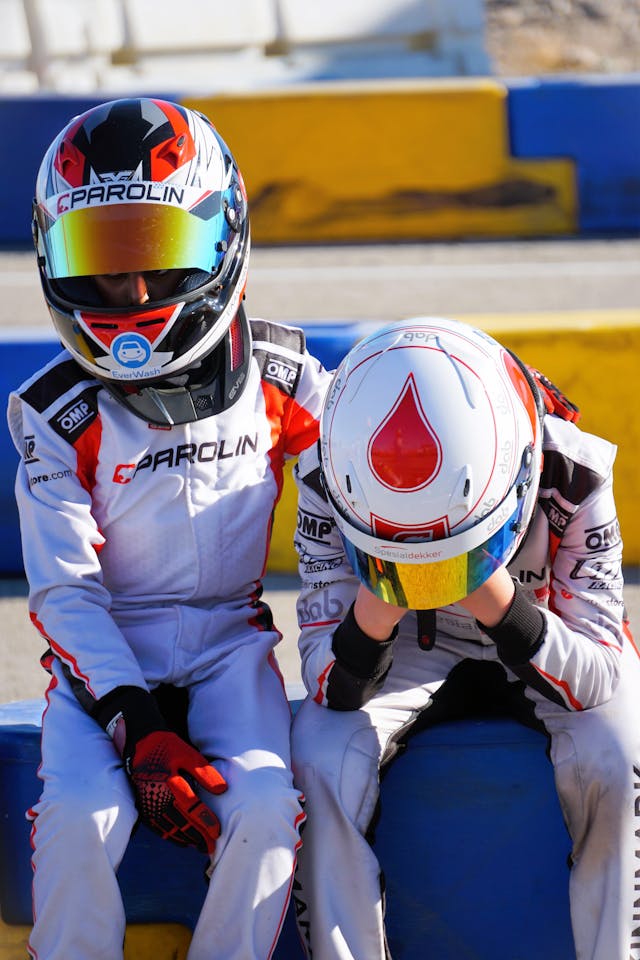Karting’s biggest stage hosts an all-time great race

Which race do you consider to be the greatest motorsports event in the world? Is it the 24 Hours of Le Mans? Perhaps, the Indy 500? Or, maybe you favor something more extreme, like the Isle of Man TT bike race or Pikes Peak Hillclimb? I would like to add a lesser-known event to the list of title contenders: The Superkarts! USA (SKUSA) SuperNationals.
This karting event in Las Vegas, Nevada annually provides high speed and high stakes. It is a collection of the world’s top motorsports drivers with varying agendas and equipment. These aren’t your local family fun center five-horsepower karts. No, these are lethal machines that pull big g-force numbers in the corners and high digits down the straights. Speed, history, prestige, and close competition–this race, like its well-known crown jewels counterparts, has it all, and I’ve know this for a while.
Fresh out of college, in the early 2000s, I worked for SKUSA and helped conduct some of the largest events in karting history. SuperNationals is widely regarded as the most prestigious karting event in the world. The race–and SKUSA, in general– have helped evolve karting into the professional motorsport that it is today. I hold them in such high regard but haven’t attended a SuperNat race since 2003. To see if it could still be consider one of the greatest motorsport events in the world, I attended the 24th running of the great kart race in the desert.
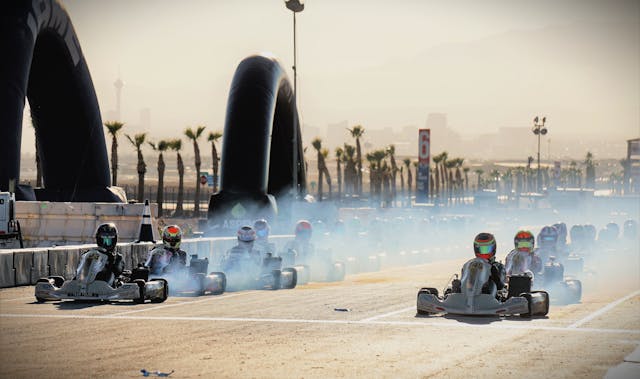
I was nervous when I landed in Vegas. I was worried that the event may not be as impressive as a spectator as I thought it was, as an employee. I was there to lend a hand for the first-ever SuperNats–right off the famed Las Vegas strip, in the Rio casino parking lot.
There was something magical those first several years. The 2002 SuperNats–the first race held on the strip–propelled karting forward. We worked with a fresh-faced TV owner named Mark Cuban (yes, that Mark Cuban) and his channel HDNet to become the first motorsport ever televised in high-definition. (Formula 1 wasn’t televised in high-def until 2011.)
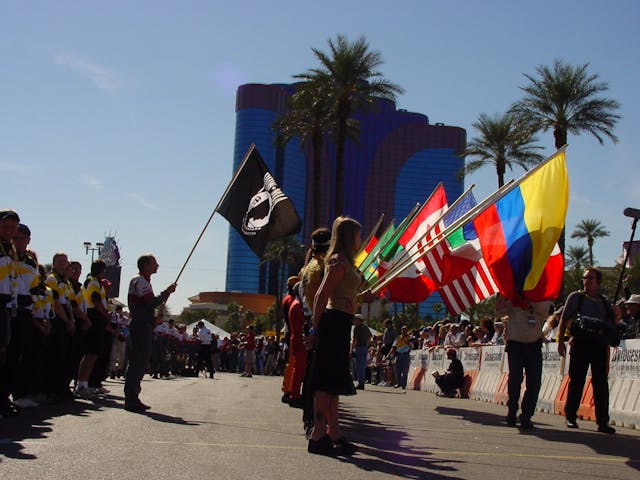
As big as those early SuperNats were, I quickly learned that the event has only grown each year since since my last visit. From the moment I walked in the venue, I began spotting legends–Juan Montoya, Will Power, and Joseph Newgarden. Due to a crazy last-minute change–when the Rio unexpectedly cancelled SKUSA’s reservation only two weeks before the event–the race was held right outside Nellis Air Force Base at the Las Vegas Motor Speedway.

History
The SuperNationals’ reputation as the world’s biggest and best karting event didn’t happen overnight. First, the sport had to evolve from “go-karts”, and that began with one man’s vision.
SKUSA’s inception goes back to the late 1990s. A new kart racer, named Jim Murley, who had worked in motorsports most of his life, realized the racing series needed help in promotion and organization. At the time American go-karts were largely a hobby, the races were run by volunteers, and hardly anyone was making a living in the business. Jim wanted to introduce this sport to the world. The company’s founder, Don Janowski, decided to put on a race in Las Vegas in the winter so that drivers from the Midwest could have a warm vacation. Murley viewed manual transmission karts, called “shifterkarts,” as the most exciting racing he had taken part in, or even watched. He dreamed of the sport becoming bigger and more professional. He hypothesized that a national association with consistent and skilled officiating would draw top-tier racers. He was right.
When Murley took over SKUSA, he established smaller regional series throughout the country. He wanted to make the drivers the stars, so he started a full-scale pro tour where he hoped the best drivers from each region would show up. Furthermore, he wanted a series like NASCAR or Formula 1 for karters so the best teams and drivers had a place to battle. Murley’s background in motocross helped him create a standardized rulebook and inspired him to assign winners national numbers, build a podium that featured champagne celebrations, establish autograph sessions, and even award actual money to winners. Each event began with official opening ceremonies with national anthems and the flags from each driver’s home country. It didn’t matter if there were no fans other than family in the stands, this was big time and the teams loved it. His biggest investment was in his “A-Team,” a group of karting officials from around the country that flew in for every pro event.

This level of presentation and organization was wildly different than anything seen in go-karting at the time. Before SKUSA the karting landscape was a mess. It was a hodgepodge mix of series, following different rules, running all over the country, with no way to really tell who was the best karter. Karting teams noticed the investment and began to change. What started as family teams with go-karts in the back of pickups quickly turned into big rigs and high-end motorhomes filled with top racers from other continents. Murley was a charmer and instilled hope in the drivers that they could become something great. Many of them did.
Next up: the name. Go-karts are fun, hobby machines. Murley wanted professional racing. Kart racing. Jim Murley wasn’t the father of karting (as most say Duffy Livingstone and Art Ingels deserve that title for their 1950s karts), but he was the one to take the sport to the next level. He bought a full-size semi-truck to attend each pro race and painted down the side his signature taglines: “Not Your Daddy’s Go-Kart Club. 125+mph Kart Racing. It’s an Attitude.” Many people have been involved in growing karting over the last 60 years, but it took Jim Murley’s vision, innovation, and charisma to grow karting in the 1990s and 2000s.
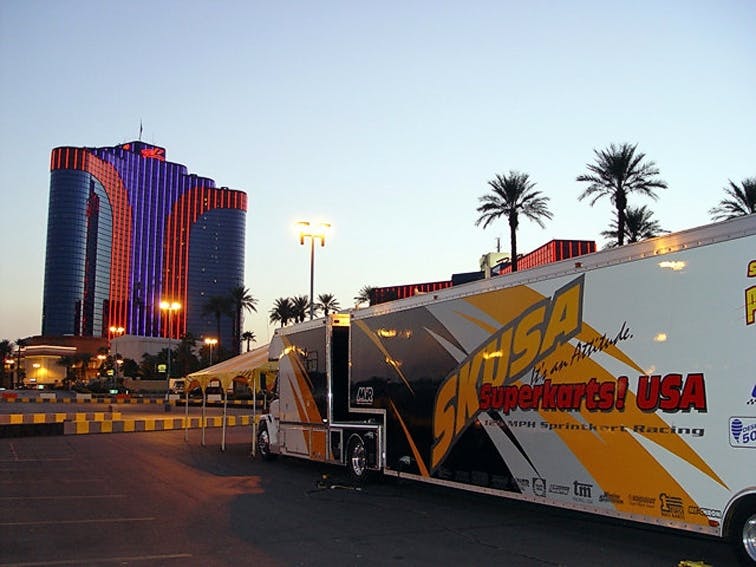
Polished SKUSA needed a marquee event. Every series has its version of the Indy 500. Murley and crew established the season finale in Vegas as its crown jewel with big names on track and off. I remember being starstruck that Alfonso Ribero–who played Carlton from The Fresh Prince of Bel Air–was singing the national anthem and racing in 2002. It was huge. Every class was sold out, vendors came from all over the world, and we were live on TV. What makes the SuperNats unique is that it is always a temporary track built just for that weekend, so no one has an advantage. SKUSA crews come out weeks in advance to start building a world class facility out of a parking lot. Imagine if Indy’s stars couldn’t view the course layout until raceweek.


Those early SuperNats quickly became the steppingstone young drivers needed to make the big leagues. Guys like Scott Speed (F1, NASCAR, rally) and A.J. Allmendinger (NASCAR, IndyCar, IMSA) were battling one another on track, and each of them used a SuperNats victory to help make the leap into top-tier divisions and secure sponsors like Red Bull. The racing world took notice. Nowadays, world champion karters fly around the globe to be at the SuperNats and battle with more than 500 other drivers each year.

Speed
There are a variety of chassis, motors, and transmissions when it comes to professional karting. The SuperNats, though, focuses on sprint karts. This year, nine classes featured powerplants that ranged from 60cc to 175cc. 20 years ago, the motors were mostly Honda and Yamahas yanked from dirt bikes. Now, purpose-built kart engines can reach up to 45 horsepower and spin at over 15,000rpm. Some are shifterkarts, with 6-speed sequentials, while others feature a single speed. Each kart is made of tubing with no suspension, pulling over 4Gs in the corners, all while racing about an inch off the ground with no seatbelt. “Driving a shifterkart around a track is very similar to driving a Formula 1 car around a track,” says three-time SuperNats winner Scott Speed. “It’s just on a smaller scale.”
Sprint tracks are between 0.7-1.0 mile in length, with speeds reaching close to 100mph. Oh, and they can do 0-60 is under 3 seconds, which is faster than a majority of road-going commuters.

To give you an idea of the speeds at this year’s event, the Pro Shifter drivers were averaging 58mph over a tight 0.7-mile, 13-turn track that included multiple slow hairpin corners. That class was stacked with talent from 14 different countries including two FIA World Karting champions and the most recent Rolex 24 at Daytona winner and IndyCar rookie Devlin Defrancesco. The winner Matteo Vigano took home a cool $10,000.

Prestige
SKUSA has grown from stepping to stone, to a full-on race series where the stars of all autosport want to race. This is not a grassroots motorsport event. This is big money professional racing. The event starts with practice on Wednesday, qualifying Thursday, heat races Friday and Saturday, then “SuperSunday,” which features all the main events.
Ask anyone in karting and they’ll tell you that the SuperNats stands alone in its karting prestige. It was awesome watching Nick Bruechner pass 27 karts in 24 laps in the KA100 main. More astonishing was the fact that he was diagnosed with cancer in 2019 and literally skipped a chemo treatment just to race this year.
On the weekend of my visit, I sat down with the current SKUSA CEO Tom Kutscher, who took over in 2006 after a stint as a SKUSA racer and sponsor . I witnessed a passion for the sport that I hadn’t seen since Jim Murley. He simply insisted that this event needs to shine, and does anything it takes to make that happen. “These are 500 of the best kart racers in the world. And they don’t do temporary tracks in Europe, so international drivers come here to see it for themselves. Then they keep coming back, well, because it’s the SuperNats,” says Kutscher. “We have drivers from 50 countries represented out there today. Everything’s on the line for one time, one race. That’s what makes it the best.”
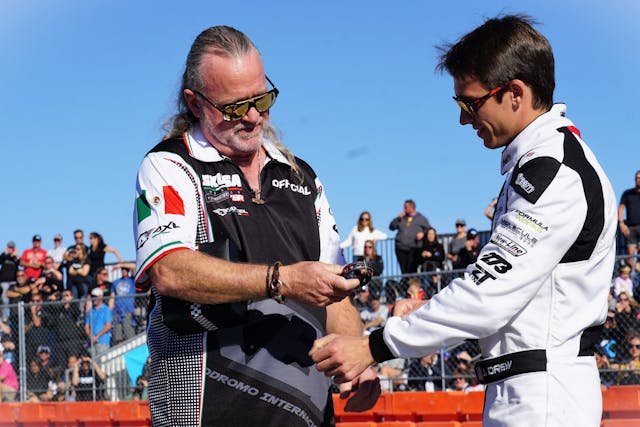
Competition
2021 was a good year for SuperNats alumni: Dayton 500 Winner Michael McDowell, NASCAR Cup Series race winner AJ Allmendinger, Indy Lights Champion Kyle Kirkwood, IndyCar race winners Colton Herta, Pato O’Ward, Joseph Newgarden, Will Power, and F1 Champion Max Verstappen

Similar to NASCAR in the Sixties, kart manufacturers learned that winning on Sunday at the SuperNats would mean selling on Monday. SKUSA developed a license structure that allowed drivers to race in the top tier classes only after they had gained experience in the lower “semi-pro” classes. This was an effective approach and turned the headline race into a true star-studded affair. Now the manufacturers could hire an ace driver to rep their product.
Extreme sports and motocross superstar Travis Pastrana attempted his first SuperNats race in 2003. Other big names would follow including Jamie McMurray, Lance Stroll, Pato O’Ward, Colton Hera, Alexander Rossi, George Russell, Rubens Barrichello, and Max Verstappen. “It was an opportunity of a lifetime to race karts against the best drivers in the United States,” said Pastrana. “I was truly amazed at the competitiveness and intensity of this race.”

One driver totally rocked the SuperNats world with his appearance in 2009. The excitement around the event was fever pitched as seven-time Formula 1 World Champ Michael Schumacher flew to Vegas just for his shot at a SuperNats title. Even after being out of karting for years, Schumacher finished an impressive seventh in what was considered the greatest and largest karting event in the over 50-year history of karting in North America.

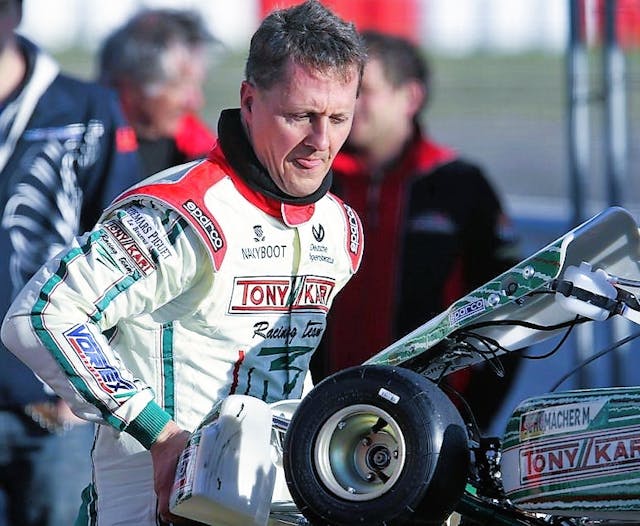
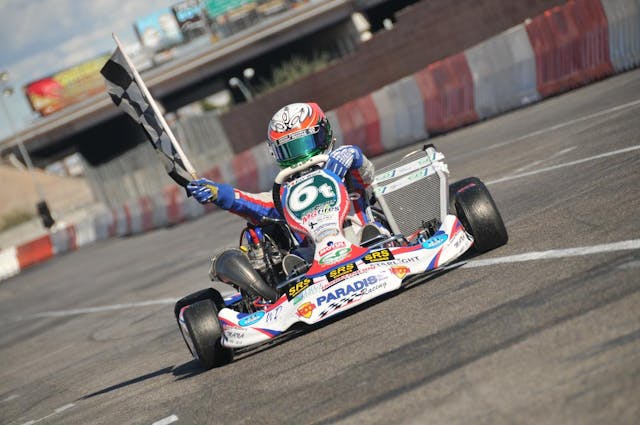


In 2012, it was Max Verstappen’s turn to give it a shot and he won pole. He was leading the final, too, before a mechanical failure sidelined the F1 champ.


Back at the 2021 SKUSA SuperNats
I noticed a difference in karting right away walking around the SuperNats. For one, it’s now $1,300 to enter. And most of the drivers are just that — drivers, and drivers only. They don’t change their own tires. They test. And test. And test. Many drivers travel with their own mechanic and driving coach.

I met full-time motor builders who charge a huge premium just to tune your engine. There are teams that put motors through their dyno rooms, and then turn around and charge for over $1,000 per engine, per event. Instead of the karts showing up in the back of pickups, I’m walking between trailers that were purchased from NASCAR teams. The drivers have their own custom motor coaches as well.


Many of the drivers were flown in by teams to drive for the big events. Of that group, some shoes spend over 200 days in the carbon fiber kart seat.
I spoke to a parent who is committed in developing their young son to become a race car driver. She said that they were never fully ready for the expenses related to karting when they entered a few years ago and now realizes they will need external support if he were to make karting his career. They estimated this weekend would be $5,000-$8,000, not including travel expenses. Of course that doesn’t include the cost of the kart, driving suit, or helmet–which a lot of drivers paint special for this one race.

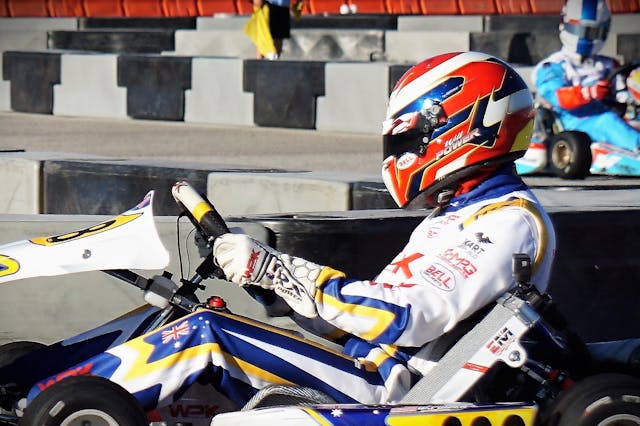
True to previous years, the stars were out. This year regular Will Power brought along Penske teammate Josef Newgarden. J-New was visibly excited, and Power was, well, grounded. He told me on Friday of the event he had already called his wife and told her he booked a flight home for Sunday morning because, as he explained with a chuckle, “there was no way I’m going to make the final.”


Whether it was Power or a parent, everyone on the property had their unique reason for attending this year’s SuperNats. I caught up with 2007 Daytona 500 winner and 2014 NASCAR champ Kevin Harvick to ask why he and his son were so far from North Carolina. “We race where the best competition is. The American motorsports world doesn’t get it yet,” the elder Harvick shared. “They don’t realize the level of talent that is in karting on the national level. Even parents out there in the stands right now don’t know how good their kids are. This is top top tier racing. American motorsports teams and fans better figure it out or we will lose all this top talent to other race series around the world. This is our first SuperNats but we will do the whole SKUSA Pro Tour next year.”
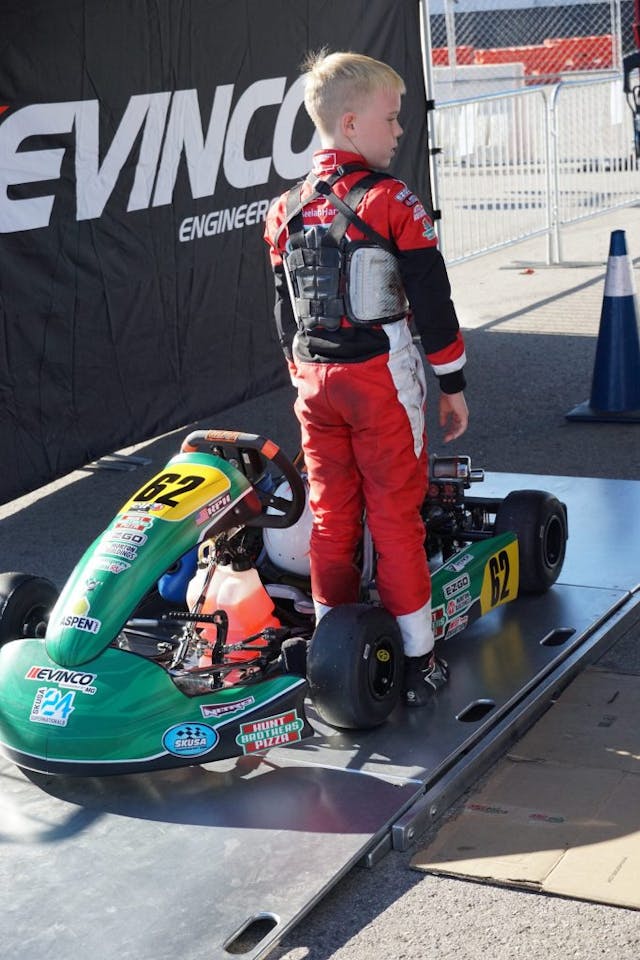
I asked if he wanted his son Keelan to follow in his footsteps to NASCAR someday. Harvick replied, “Yesterday Keelan said that he wants to be an F1 driver. This morning he thought he may want to play in the NFL. He’s only 9, who knows!” Harvick’s pit area was nothing extravagant like you may expect from a Cup driver. Instead, he focused on providing his son with top training by bringing four-time SuperNats champ and current IMSA driver Connor De Phillippi as his driver coach.

The Micro Swift race that Keelan Harvick competed in was spectacular. It seemed like there were more clean passes among the pack of grade-schoolers in the final lap than in the entire F1 season . Keelan swapped places with two other drivers throughout the race and ended up winning by .053 seconds.


After Bonnier Moulton–the only person to race all 24 SuperNats–qualified fifth in X30 Master, I asked what keeps him coming back and he explained, “I’ve been to Europe and raced the world championship races and I can say that this is the coolest and biggest karting event in the world. I love karting for its simplicity and the physical nature of it, though it’s getting harder as I get older! I grew up racing SCCA with my dad and for the amount of money it takes to have a crappy race car, you can have the absolute best equipment in karting.” Bonnier added, “My goal is to be here next year and have raced in the first 25 SuperNats! Look around, the atmosphere is so freaking cool. No other race in the world has the vibe that this race has.”

After speaking to IndyCar team owner Sam Schmidt, I came away with the best understanding of why this is one of the greatest motorsports events. He told me, “When I owned an Indy Lights team I would come here to pick out drivers and found many of my champions at this race, and I’m still here prospecting. With basically no arrow, karting is so much about driver talent. As you get to higher levels of driving, so much else determines who is at the top than just the driver. I know that if they can succeed here, they have what it takes to win at the top levels of motorsport.” I could have listened to Sam for hours. He talked about how he likes to go around the pits and just listen to all the different languages being spoken, because that tells him all the top guys here. He added, “My former driver Dan Wheldon always said that karting is the purest form of motorsport. I also come here to support his family and watch his sons Oliver and Sebastian race. They were amazing today. I wish I could have seen Power and Newgarden race, but they didn’t even make the main event!”

As the event was reaching its conclusion, I asked 9-year-old Mini Swift driver Asher Ochsteinto how he felt about his first SuperNats experience, and he wouldn’t respond at first. He was heartbroken. His podium finish was removed after a three-second penalty dropped him from third to ninth. I shared how impressed I was by the young driver. I asked if he had ever signed his autograph for a fan yet. His head titled up and his eyes followed. “No, I haven’t before.”
“Then let me be the first to ask,” I replied. Luckily, I still had my SuperNats program and a Sharpie.
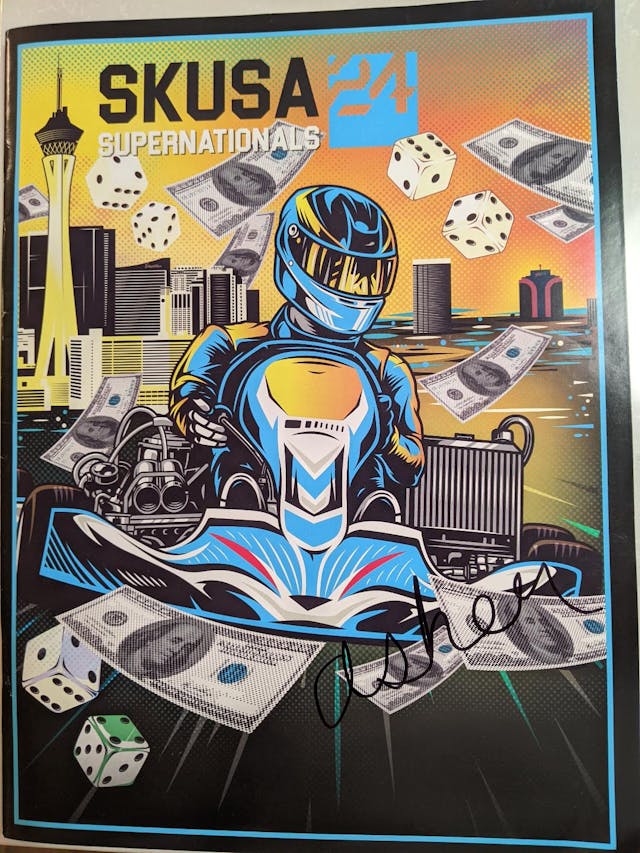
Watching his attitude change was a good reminder that even though their driving skill makes them seem like seasoned veterans on the track, these are still just kids. Asher told me, “My dream is to be a Formula 1 driver.” If determination is any indicator for future success, he just may get there.


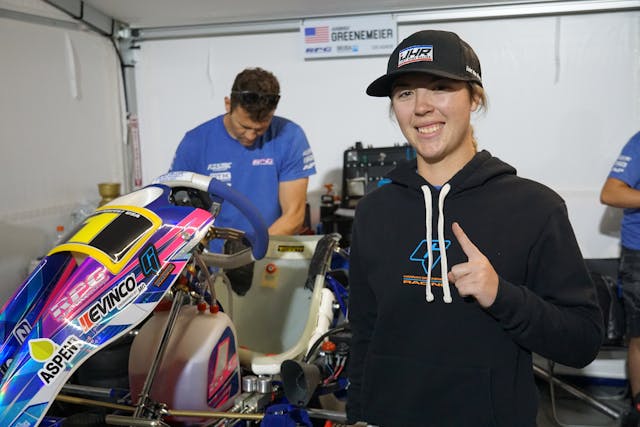
I spoke with Hannah Greenemier–the first female to win a SKUSA Pro Tour Championship–before her race.”I race the SKUSA SuperNats because everyone from around the world comes here so we get to see how we stack up. The equal skill level and competition between the drivers I think is comparable to an F1 field. Being one of the few girls makes me a target. No guy wants to be beat by a girl. But being the Pro Tour champ means it happened a lot this year,” says Greenemier with a smile. “Look at an F1, NASCAR, or IndyCar field. All of our hero’s start racing somewhere, and for a whole lot of them it was right here at the SuperNats.”

All levels of SKUSA racing now use Hagerty Motorsport Reg for their registration, payment processing, and membership. And they use Hagerty’s Race Hero for their day of timing and scoring. The product at this event was amazing with live timing and scoring on the app. I haven’t seen this level of professionalism at any level of motorsports event before. Most people think of Hagerty for their classic car insurance, but through Motorsport Reg they are now helping put on over 7,000 smaller motorsports events per year! SKUSA has used the product since 2017.
On top of Motorsports Reg, SKUSA has incorporated a lot of technology to elevate officiating in karting. Weeks before the event, the SKUSA team laid 7,000 feet of wires and cables to set up 20 cameras used for proactive–and reactive–penalties.

Every driver has their tires, kart, and engine scanned each time they exit the track. There are four marshals that watch the activity on track from lifts, two watch from the ground, and 16 additional flagmen.

SKUSA’s Director of Information Technology, Tony Leone, was very proud of the efficiency of the race weekend. “Every 15 minutes, 40 new drivers get through tech inspection, weighing, gridding, and out on the track,” he said. “People come here because of our history, our reputation of professionalism and organization, and that it is just so fun here. Plus, they all want to race against the best, and the best are all here.”

Leone took me to race control overlooking the track. “Look around this room if you want to know how serious SKUSA takes technology and officiating now.” Pointing at some of the people monitoring TV screens and determining penalties in real time, “The people in this room’s other jobs include IMSA, NASCAR, IndyCar, and IMSA scoring. Our flagman Aaron Likens is also the head IndyCar flagman.

Former IndyCar and IMSA race director Beaux Barfield is the race director, too. I asked Barfield what drew him to working with SKUSA. “This here is a world class event. I like educating and coaching drivers and parents. I love teaching and karting gives me that opportunity. The acceptance of our calls was better this weekend than I expected, and I believe the reason is the level of talent we have in the timing and scoring building and the technology we have around the track.”

After being away for 20 years, the SuperNats still impressed your author. No karting race has risen to the same level as this annual Las Vegas spectacle. Sure there are other big-ticket kart races, but SuperNats is the one everyone wants to win. Move over Indy 500, SuperNats is joining you on the list of greatest motorsports events.

